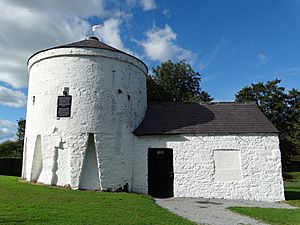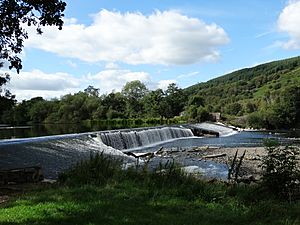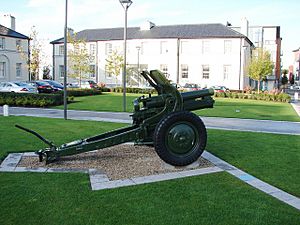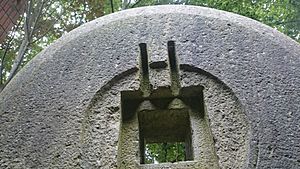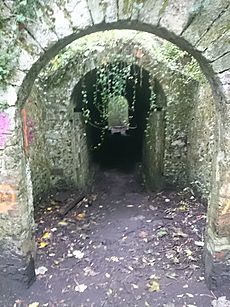Ballincollig Royal Gunpowder Mills facts for kids
The Ballincollig Royal Gunpowder Mills was a very important factory in Ireland. It was one of three main places that made gunpowder for the British Government. These mills were located in Ballincollig, close to Cork city.
They first opened in 1794 as a private business. But during the Napoleonic Wars, the British Government took them over because they needed a lot of gunpowder.
Later, in the mid-1800s, the mills went back to being privately owned for a while. They finally closed for good in 1903. Years later, Cork County Council bought the land. They turned it into a public park and opened a visitor centre. Even though the visitor centre closed in 2002, you can still visit many of the old mill buildings in the park today.
Many of the remaining buildings, even though they are ruins, are protected as National Monuments. This means they are important historical sites.
Contents
History of the Gunpowder Mills
The Royal Gunpowder Mills started in Ballincollig in 1794. A man from Cork, Charles Henry Leslie, set them up. He chose Ballincollig because it was near Cork city. It also had a flat valley and good water power from the River Lee. Leslie built a special wall called a weir to create a strong flow of water. He also dug a canal, about 2.4 kilometers long, to power his first two mills.
The gunpowder mills became very important because they were so close to Cork Harbour. After the 1798 Rebellion, the British became very interested in them. In 1804, Leslie leased the mills to the British Board of Ordnance for a very long time.
To make enough gunpowder for the British Army during the Napoleonic Wars, the mill site grew ten times bigger! Twelve new mills were added, along with buildings for processing and homes for workers. To keep the site safe, a barracks was built in 1810. Soldiers also guarded the wagons carrying powder to Cork Harbour. The whole area was huge, covering about 1.76 square kilometers, and was surrounded by a tall stone wall.
After the Napoleonic Wars ended, people didn't need as much gunpowder. So, the mills closed in 1815. They stayed empty for nearly 20 years. Then, in 1834, two men from Liverpool, Thomas Tobin and Charles Horsefall, bought them. They updated the mills, making them one of the most modern factories in the country.
Ballincollig continued to grow in the mid-1800s, even during the Irish Potato Famine. About 500 men and boys worked at the mills then. They had many different jobs, like making barrels, fixing machines, and special gunpowder-making skills. In 1886, the town of Ballincollig had a population of 1,130 people.
At this time, most of the powder made was blasting powder. This was used for building new railways, mining, and quarrying.
Later in the century, the mills started to decline again. This was because new types of explosives, like nitroglycerine, were invented. People didn't need as much black gunpowder anymore.
The mills finally closed in 1903, after the Boer War. This had a big impact on the local community. Eventually, the land was owned by a company called Imperial Chemical Industries (ICI).
Jobs at the Mills
Making gunpowder needed many different skills. In 1815, some of the jobs included: carpenters, coopers (barrel makers), millwrights (machine builders), master mixers, and people who refined sulphur, charcoal, and saltpetre. There were also workers for the press-house, corning house, glazing house, and dusting house.
Millwrights: The Machine Builders
One of the most important jobs in the 1800s was the millwright. These skilled workers built and looked after the waterwheels. These wheels powered all the machines in the mills. At its busiest in the 1850s, Ballincollig had over 20 waterwheels! They were in the main mixing mills, the charcoal mill, sawmill, and other processing buildings.
Millwrights often worked on site. A key part of their job was making sure the gears, which moved power from the waterwheels to the millstones, fit together perfectly. They found that gears made of iron and wood worked best. The wooden gears would wear out first, which was easier to replace. This also made the machines run more quietly and smoothly.
Gunpowder Makers
The people who prepared the charcoal, sulphur, and saltpetre were very important. Gunpowder had to be consistently good, and this depended on having very pure ingredients.
The mixer's job was to combine these three ingredients. This mixture, called the 'green charge', was kept in small, low buildings. Then it was taken to the incorporating or composition mills. This was the most crucial step because it was where the gunpowder was actually made. It was also a very dangerous job. Two large millstones, called edged runners, ground the mixture in a special trough. The workers stayed outside, only going in to add distilled water and make sure the mixture didn't stick to the wheels.
Coopers: The Barrel Makers
What Coopers Did
Coopers were skilled workers who made barrels or casks. These barrels were made from wooden staves (strips of wood) held together by hoops of copper or wood. They had a top and bottom. The barrels were made of oak and had to be extremely tight. This was to stop any dampness from getting into the gunpowder when it was stored. Copper nails were used because they wouldn't cause sparks. In the late 1830s, the Ballincollig mills made 16,000 barrels of gunpowder every year. By 1856, about 50 coopers and their apprentices worked there.
Coopers had to complete a five-year apprenticeship. Apprentices had to be at least 14 years old and able to read and write. Their training followed the rules of the Cork Coopers Society. They usually worked long hours, from 6 am to 6 pm in summer. Many coopers in Ballincollig had their sons join the trade.
Why the Job Declined
From the 1870s, the number of coopers at the Ballincollig Powder Mills started to decrease. This was partly because less gunpowder was being made. But it was also because the mills started using metal containers for sporting powders instead of barrels. Sometimes, barrels were even brought in from the Royal Arsenal in Woolwich, England, instead of being made locally.
The coopers faced tough times. In 1889, many powder mill workers, especially coopers, were struggling to find work. Some went to England to find jobs. In 1892, the coopers had a disagreement with the management. They were upset because imported barrels meant they were earning very little money.
In 1886, coopers also went on strike because new machines would cut their already low wages by a third. The company threatened to close the cooperage and use machine-made barrels. It was a difficult time for coopers in Cork generally.
Because there was less demand for their work, coopers and their families started to move to England in 1889. Some found jobs in England and Scotland. Others found temporary work elsewhere in Ireland. When the Powder Mills finally closed in June 1903, coopers asked their society if they could find work in Cork City, but the society said no.
Dangers at the Mills
Making gunpowder at Ballincollig, and moving it through Cork City, was very dangerous in the 1800s. There were many accidents, some of them deadly. From the early 1800s, people knew how risky it was to transport such a dangerous substance through busy streets.
Several accidents happened at the mills early on. On November 10, 1803, two barrels of gunpowder exploded, and five men died. Five years later, on August 25, 1808, another "dreadful explosion" killed more people. The shock waves from both blasts were felt all the way in Cork city.
Dangers in Cork City
The city itself also faced dangers from the gunpowder. In August 1803, gunpowder wagons were moving along George's Street (now Washington Street). One barrel spilled, and the powder trickled onto the ground. A spark from a carman's stumble caused the spilled powder to explode. Luckily, no one was seriously hurt, but it was a scary warning. A local newspaper wrote about it, urging everyone to be more careful.
The newspaper also warned about storing large amounts of gunpowder in shops in the city. They suggested keeping powder in a separate storage place and only allowing shops to have small amounts. In 1805, the mayor of Cork was praised for finding a grocer who had too much powder. It was taken away and stored safely. More safety steps were taken in 1806, like shipping gunpowder from Blackrock instead of the city's docks.
In November 1810, Ballincollig gunpowder was linked to a major disaster in Cork city. Around 10 pm on November 3, a huge explosion shook the Brandy Lane area. Three houses were destroyed, and others caught fire. People rushed to help. Rescuers worked all night. By morning, 19 bodies were found, and three more people died later in the hospital, bringing the total to 22. The cause was believed to be a mill worker stealing gunpowder from Ballincollig. He sold it to quarries nearby and brought small amounts home to Brandy Lane each evening. It was thought that carelessness while drying the powder with candles caused the explosion.
Mill Explosions
A fatal accident happened at Ballincollig Powder Mills on June 25, 1841. Two men were killed by an explosion in the corning house. Two years later, on July 29, 1843, John Carol and Jeremiah Long died in another explosion at the granulating mill. There were 21 barrels of gunpowder inside. A massive explosion rocked Ballincollig, destroying the building.
Just three years later, two men were injured when another mill exploded. In April 1847, soldiers helped put out a fire at the cooperage to stop it from spreading to the nearby powder store. In June 1858, an explosion destroyed a small mill, but no one was hurt.
Between 1859 and 1862, three more explosions killed a dozen people at the mills. The first was in August 1859 in the dusting house, where dust was removed from gunpowder. Five men were killed instantly. The cause was a mystery, possibly friction between barrels or a spark.
A new 'pressing mill' was built on the site. On October 23, 1861, another explosion happened there, killing five men. It was later found that one of the men had brought alcohol into the mill, which was against the rules. The Cork Examiner newspaper called it a "fearful warning."
The third deadly accident happened almost exactly a year later, on October 25, 1862, in the drying house. Thirty barrels of gunpowder exploded, completely destroying the building. Two men, John Hallissy and David Leahy, were killed by falling debris.
More explosions happened in the following years. In January 1864, a blast at one mill caused a chain reaction, blowing up three others. In October 1869, three sheds were destroyed. In June 1870, two more sheds were demolished. In April 1872, John Corcoran died after an explosion, and his companion was badly injured. In March 1877, Thade Connel was severely burned in an explosion at the incorporating mill and died a few days later. Workers were not allowed in this building when the machinery was running, and it was thought Connel might have been scraping powder when the blast occurred.
Closure and Reopening
The Ballincollig Powder Mills stopped being used a few years after the Napoleonic Wars. The Duke of Wellington ordered that the wooden parts of the factory be taken down, but the foundations should be saved. The machinery was kept oiled and painted. Some equipment was sold in 1831, and many buildings became run down. By 1834, Sir John Tobin and Company from Liverpool took over the mill complex.
Reopening as a Private Company
Within a few months, the complex was being fixed up. Workers cleared out the old waterways. By mid-1835, the Ballincollig mills, now called the Royal Gunpowder Mills Company, started making gunpowder again. They were paying almost 200 pounds a week in wages. Before the end of the 1830s, about 200 people worked at the mills. They produced around 16,000 barrels of gunpowder each year.
To make the site safer, different departments were placed far apart from each other. Materials were moved on small canals. This avoided sparks that could come from horses' hooves. Between 1836 and 1842, the amount of gunpowder exported grew steadily, reaching over 17,000 casks in 1842.
Having so much gunpowder moving through Cork city worried people. In June 1842, the Harbour Board discussed it. They agreed that great care was needed when shipping the material. They suggested moving the shipping point further down the river to Rochestown. Later, there were ideas to build a new road or even a canal to transport the gunpowder from Ballincollig to Cork more safely.
Images for kids


